The Electronic Intifada 2 September 2005

The Wall around Qalqiliya. A twenty-five foot high concrete cage cuts residents off from their agricultural land, necessary for their survival, and prevents you from traveling even 5 minutes out of the City. A single gate, open at the whims of the occupying army, controls 100,000 residents. (Photo: StopTheWall.org)
Whitewashing the Wall
In June 2003, I received an e-mail in EI’s inbox from a Nathan Edelson, who introduced himself as “a design critic whose features on architecture have been published in major U.S. newspapers,” which a Lexis-Nexis newspaper database supported. He was writing a story “about architecture in Israel, with emphasis on the new security ‘fence’ which you rightly call a wall.” His request was for larger images of the Israel’s West Bank barrier for study, and explained that “the premise of my article is that one can argue about the desirability of a wall, and certainly where it runs, but if it is going to be built it should not be an aesthetic monstrosity.”
As you can imagine, we get a lot of crazy mail at EI, ranging from the fundamentalist who has for years been weekly mailing Zen-like one-liners such as “Biblical Christianity will one day return to the Holy Land,” to the ex-Israeli soldier who sent photos of him in service across the occupied territories with accompanying narratives of how much he enjoyed mistreating the Palestinians he came across. But somehow, this e-mail from internationally-respected design critic Nathan Edelson won my vote for the most clueless communication that info@electronicIntifada.net has ever received.
Usually, all correspondents to EI receive a polite response with links to more information. But when a clearly educated person tries to get you to swallow soup with a turd in it, there’s got to be a cut-off point for pleasantries.
“That’s a little,” I replied, “like arguing for nice faux painting on gas chamber walls or calling for Martha Stewart torture chamber bed sets. Clearly ethics play no part in your school of design criticism.”
Edelson’s reply was truly surreal. “I could accuse you of having no ethics because you want the security wall to be as repulsive as possible so it will stir up the maximum possible resentment, which will translate into more violence.”
“I care very much about where the security wall runs,” he continued, “as well as how it looks. My upcoming article will hopefully elicit meaningful conversation between the sides based on a joint desire to make a bad thing better, and this can help create the trust which can change not only the look but the routing of the barrier.”
Of course, the second the beautification of the barrier is complete, the Israelis, who bulldozed and confiscated countless acres of Palestinian land to build the wall, cut off thousands of farmers from their sole livelihood and, in one example, surrounded a single Palestinian family home in a mini-wall, will sit down for a meaningful conversation with their new Palestinian friends about the route of the finished barrier! I was also chastised by Edelson for being less than “civil” in my response to him.
“There is nothing you can do aesthetically,” I wrote in my reply to Edelson, “which will make this wall benign. There is no making it ‘better’. Want a big picture of the wall? Here’s one attached. Do you think a nice mottled green would help it blend in to the indigenous landscape nicely? Or perhaps some arches and battlements for a more traditional medieval flavor?”

This satellite image of Qalqilya and Israel’s West Bank Barrier surrounding the city was taken on 7 June 2003. The progress of construction of the barrier can clearly be seen, ultimately cutting off residents from their surrounding agricultural land. See here for before & after images. (Photo: Space Imaging/NTA Space Turk)
“If you actually intend to actually write an article arguing for this monstrous whitewashing of a visible human rights violation — and it says so much about the state of ignorance in America that you are even thinking of it or if indeed there is any likelihood any serious newspaper would print it — I would suggest you first get on a plane and go visit Qalqiliya and Rafah and see the reality for yourself. Speak to the people who live there. See how the thing plays out on the ground.”

Hitler with Leni Riefenstahl (R), an otherwise brilliant film maker who made propaganda films for the Nazis.
“Hats off to Nathan Edelson, the man who came up with the wonderful solution to a century of conflict: simply paint the cage a new color and watch the prisoners dance.”
Edelson didn’t give up, and responded one last time, expressing hope for a resolution to the conflict, making a final statement about the aesthetics of the barrier. “I also believe, however, that given any particular routing decision, it is immoral to create any more ugliness than is absolutely necessary.”
Enter Banksy
When I first encountered some of the graffiti art and sculpture of “Banksy” in London several years ago, I was struck by the importance of where his pieces were located. In Banksy’s work, location itself is a large part of the message, a key component of the resulting metaphor. Whether he’s hanging a fake rock pictogram of early man pushing a shopping cart in the British Museum, or installing an amalgam of the Statue of Liberty and Statue of Justice clad as a prostitute at the site of his last arrest, the environment is usually part of the message.
The “Manifesto” on Banksy’s website contains only a diary extract from Lieutenant Colonel Mervin Willett Gonin DSO, who was among the first British soldiers to liberate Bergen-Belsen in 1945:
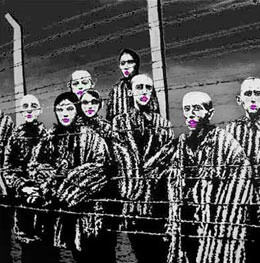
The Holocaust Lipstick motif in Banksy’s art (see above right), which accompanies the text on his website, has also appeared on the streets of the UK and aptly captures the deliberate incongruity of his large body of public work, which highlights and satirizes the dehumanizing impact of modern society and government by disturbing our sense of place and appropriateness.
Familiar images — the Queen, smiling children, policemen — are given a dark twist designed to wake observers up from the 9 to 5 rat race — also a common Banksy theme, typically delivered in person by talking rats — a rat race that literally itself streams through Banksy’s borderless gallery of streets to make you reassess the structures and symbols that form the backdrops to our lives.
Banksy hacks the Wall
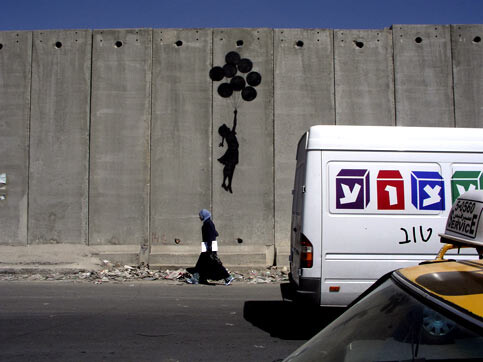
Whereas Nathan Edelson wants to create no “more ugliness than is absolutely necessary”, Banksy’s the kind of guy who prefers to draw a 20 foot high arrow pointing at the ugliness to encourage us to ask why the hell it’s there in the first place.
When I first learned of Banksy’s summer trip to the route of Israel’s West Bank barrier, which the artist describes on his website as “the ultimate activity holiday destination for graffiti writers” — I knew even before I saw the first image that this was going to be interesting.

“How illegal is it to vandalize a wall,” asks Banksy in his website introduction to his Wall project, “if the wall itself has been deemed unlawful by the International Court of Justice? The Israeli government is building a wall surrounding the occupied Palestinian territories. It stands three times the height of the Berlin wall and will eventually run for over 700km - the distance from London to Zurich. The International Court of Justice last year ruled the wall and its associated regime is illegal. It essentially turns Palestine into the world’s largest open-air prison.”
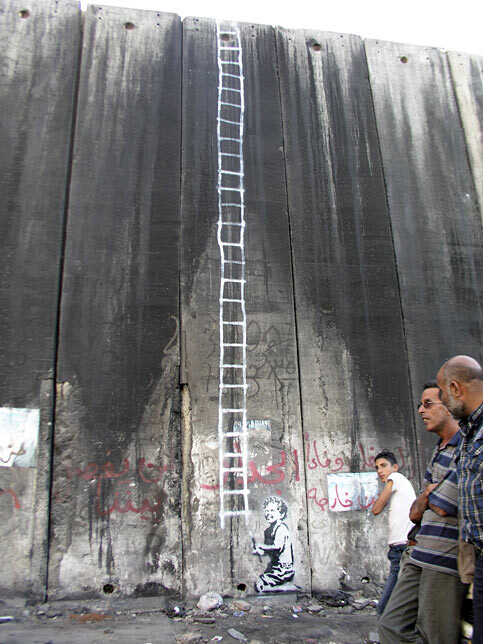

Much of the art he produced on the Wall visually subverts and draws attention to its nature as a barrier by incorporating images of escape — a girl being carried away by a bunch of balloons, a little boy painting a rope ladder.
Other pieces invoke a virtual reality that underlines the negation of humanity that the barrier represents — children in areas cut off from any access to the sea playing with sand buckets and spades on piles of rubble that look like sand, and corners of the wall peeled back to reveal imagined lush landscapes behind.
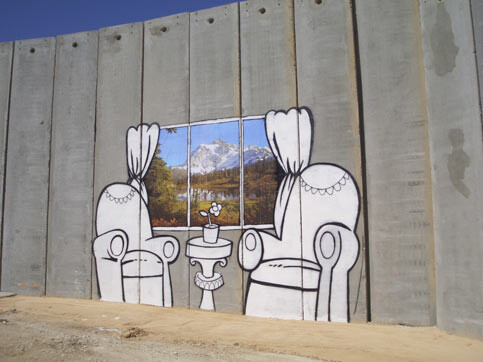


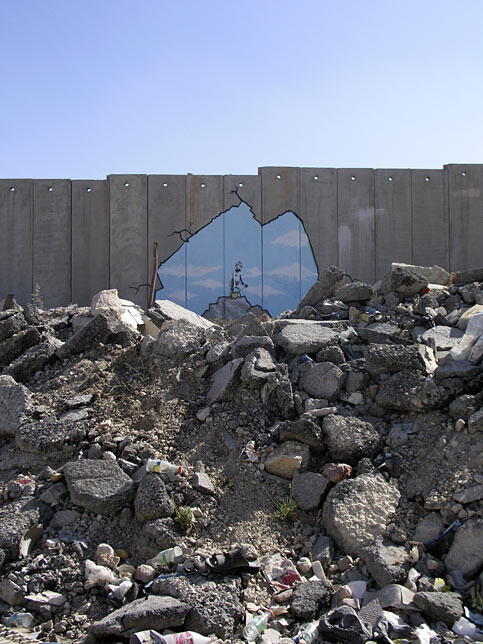
Banksy’s site offers two snippets of conversations with an Israeli soldier and a Palestinian who happened upon him while he was in the process of creating the series of nine pieces on the Wall, in Bethlehem, Abu Dis, and Ramallah.
Soldier: What the fuck are you doing?
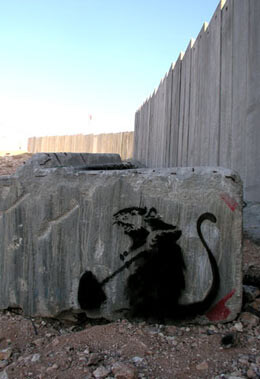
BANKSY COMPETITION! This month’s treasure hunt takes place in sunny Palestine/Israel. Somewhere along the route of the segregation wall youll find this rat. At the foot of his shovel is a flat rock with a word written on the underside. The first person to email that word into this site wins a hacked off piece of wall adorned with an original Banksy painting worth quite possibly tens of pounds. Good luck. E-mail your answer to: treasure@banksy.co.uk
Soldier (to colleagues): Safety’s off
Banksy is the anti-Leni Riefenstahl and anti-Richard Wagner, reclaiming public spaces as a space for public imagination and enlightenment where they have become propagandistic barriers to thought and awareness, as is the very terminology for Israel’s West Bank barrier itself. Banksy’s summer project on Israel’s Wall stands out as one of the most pertinent artistic and political commentaries in recent memory.
Perhaps the last word, perhaps the clearest answer to the Nathan Edelsons of this world who wish to whitewash all that is ugly rather than change its basic nature, should come from another conversation Banksy reports having with an old Palestinian man:
Old man: You paint the wall, you make it look beautiful.
Me: Thanks
Old man: We don’t want it to be beautiful, we hate this wall, go home.
Nigel Parry is a cofounder of the Electronic Intifada and lived in Palestine from 1994-1998. Today he lives in New York and works as a freelance web designer through nigelparry.net.
Related Links




